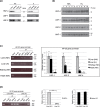HNF-4 participates in the hibernation-associated transcriptional regulation of the chipmunk hibernation-related protein gene
- PMID: 28281641
- PMCID: PMC5345028
- DOI: 10.1038/srep44279
HNF-4 participates in the hibernation-associated transcriptional regulation of the chipmunk hibernation-related protein gene
Abstract
The chipmunk hibernation-related protein 25 (HP-25) is involved in the circannual control of hibernation in the brain. The liver-specific expression of the HP-25 gene is repressed in hibernating chipmunks under the control of endogenous circannual rhythms. However, the molecular mechanisms that differentially regulate the HP-25 gene during the nonhibernation and hibernation seasons are unknown. Here, we show that the hibernation-associated HP-25 expression is regulated epigenetically. Chromatin immunoprecipitation analyses revealed that significantly less hepatocyte nuclear receptor HNF-4 bound to the HP-25 gene promoter in the liver of hibernating chipmunks compared to nonhibernating chipmunks. Concurrently in the hibernating chipmunks, coactivators were dissociated from the promoter, and active transcription histone marks on the HP-25 gene promoter were lost. On the other hand, small heterodimer partner (SHP) expression was upregulated in the liver of hibernating chipmunks. Overexpressing SHP in primary hepatocytes prepared from nonhibernating chipmunks caused HNF-4 to dissociate from the HP-25 gene promoter, and reduced the HP-25 mRNA level. These results suggest that hibernation-related HP-25 expression is epigenetically regulated by the binding of HNF-4 to the HP-25 promoter, and that this binding might be modulated by SHP in hibernating chipmunks.
Conflict of interest statement
The authors declare no competing financial interests.
Figures






Similar articles
-
Epigenetic regulation of hibernation-associated HP-20 and HP-27 gene transcription in chipmunk liver.Biochem Biophys Res Commun. 2018 Jan 8;495(2):1758-1765. doi: 10.1016/j.bbrc.2017.12.052. Epub 2017 Dec 9. Biochem Biophys Res Commun. 2018. PMID: 29233692
-
HNF-1 regulates the promoter activity of the HP-27 gene.Zoolog Sci. 2004 Apr;21(4):393-6. doi: 10.2108/zsj.21.393. Zoolog Sci. 2004. PMID: 15118226
-
The tree squirrel HP-25 gene is a pseudogene.Eur J Biochem. 2001 Nov;268(22):5997-6002. doi: 10.1046/j.0014-2956.2001.02572.x. Eur J Biochem. 2001. PMID: 11722590
-
HNF-1 regulates the liver-specific transcription of the chipmunk HP-20 gene.Gene. 2001 Oct 17;277(1-2):121-7. doi: 10.1016/s0378-1119(01)00699-0. Gene. 2001. PMID: 11602349
-
Endogenous circannual clock and HP complex in a hibernation control system.Cold Spring Harb Symp Quant Biol. 2007;72:607-13. doi: 10.1101/sqb.2007.72.028. Cold Spring Harb Symp Quant Biol. 2007. PMID: 18419320 Review.
Cited by
-
Novel transcription regulatory sequences and factors of the immune evasion protein ICP47 (US12) of herpes simplex viruses.Virol J. 2020 Jul 10;17(1):101. doi: 10.1186/s12985-020-01365-3. Virol J. 2020. PMID: 32650799 Free PMC article.
-
Reversible Histone Modifications Contribute to the Frozen and Thawed Recovery States of Wood Frog Brains.Biomolecules. 2024 Jul 12;14(7):839. doi: 10.3390/biom14070839. Biomolecules. 2024. PMID: 39062553 Free PMC article.
-
Multiple time points of transcriptome analysis revealed altered genes involved in maintaining hibernation in the hypothalamus of Tamias sibiricus.Front Neurosci. 2024 Dec 23;18:1501223. doi: 10.3389/fnins.2024.1501223. eCollection 2024. Front Neurosci. 2024. PMID: 39764389 Free PMC article.
-
Circadian transcription factor HSF1 regulates differential HSP70 gene transcription during the arousal-torpor cycle in mammalian hibernation.Sci Rep. 2019 Jan 29;9(1):832. doi: 10.1038/s41598-018-37022-7. Sci Rep. 2019. PMID: 30696859 Free PMC article.
References
-
- Wang L. C. H. & Lee T. F. Topor and Hibernation in Mammals: Metabolic, Physiological, and Biochemical Adaptations. In Comprehensive Physiology 507–532 (American Physiological Society, 2011).
-
- Kondo N. & Kondo J. Identification of novel blood proteins specific for mammalian hibernation. J. Biol. Chem. 267, 473–478 (1992). - PubMed
Publication types
MeSH terms
Substances
LinkOut - more resources
Full Text Sources
Other Literature Sources
Research Materials
Miscellaneous

